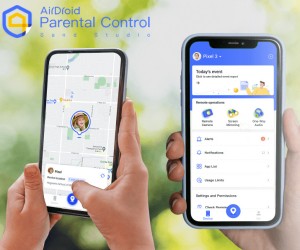Amazon Q Enterprise is a completely managed, generative synthetic intelligence (AI)-powered assistant that helps enterprises unlock the worth of their information and data. With Amazon Q, you possibly can shortly discover solutions to questions, generate summaries and content material, and full duties by utilizing the knowledge and experience saved throughout your organization’s varied information sources and enterprise programs. On the core of this functionality are native information supply connectors that seamlessly combine and index content material from a number of repositories right into a unified index. This allows the Amazon Q massive language mannequin (LLM) to offer correct, well-written solutions by drawing from the consolidated information and data. The info supply connectors act as a bridge, synchronizing content material from disparate programs like Salesforce, Jira, and SharePoint right into a centralized index that powers the pure language understanding and generative talents of Amazon Q.
To make this integration course of as seamless as attainable, Amazon Q Enterprise provides a number of pre-built connectors to a variety of knowledge sources, together with Atlassian Jira, Atlassian Confluence, Amazon Easy Storage Service (Amazon S3), Microsoft SharePoint, Salesforce, and lots of extra. This lets you create your generative AI resolution with minimal configuration. For a full checklist of Amazon Q supported information supply connectors, see Supported connectors.
One of many key integrations for Amazon Q is with Microsoft SharePoint On-line. SharePoint is a broadly used collaborative platform that enables organizations to handle and share content material, data, and purposes to enhance productiveness and decision-making. By integrating Amazon Q with SharePoint, companies can empower their workers to entry info and insights from SharePoint extra effectively and successfully.
With the Amazon Q and SharePoint On-line integration, enterprise customers can do the next:
- Get prompt solutions – Customers can ask pure language questions and Amazon Q will present correct, up-to-date solutions by looking out and synthesizing info from throughout the group’s SharePoint websites and content material.
- Speed up analysis and evaluation – As an alternative of manually looking out by means of SharePoint paperwork, customers can use Amazon Q to shortly discover related info, summaries, and insights to help their analysis and decision-making.
- Streamline content material creation – Amazon Q can help in producing drafts, outlines, and even full content material items (akin to reviews, articles, or shows) by drawing on the data and information saved in SharePoint.
- Automate workflows and duties – Amazon Q might be configured to finish routine duties and queries (akin to producing standing reviews, answering FAQs, or requesting info) by interacting with the related SharePoint information and purposes.
- Improve collaboration – By making SharePoint content material extra accessible and actionable by means of Amazon Q, the combination facilitates higher data sharing, problem-solving, and collaboration throughout the group.
On this publish, we information you thru the method of organising the SharePoint On-line connector in Amazon Q Enterprise. This may allow your group to make use of the facility of generative AI to unlock the total worth of your SharePoint funding and empower your workforce to work smarter and extra effectively.
Discover correct solutions from content material in Microsoft SharePoint utilizing Amazon Q Enterprise
After you combine Amazon Q Enterprise with Microsoft SharePoint, customers can ask questions from the physique of the doc. For this publish, we use a SharePoint On-line web site named HR Insurance policies that has details about the journey coverage, state incapacity insurance coverage coverage, payroll taxes, and paid household go away program for California saved in doc libraries. A number of the questions you possibly can ask Amazon Q Enterprise would possibly embrace the next:
- Is there a go away plan in California for brand spanking new dad and mom?
- Can I declare incapacity insurance coverage throughout this time?
- Earlier than making use of for go away, I need to submit my submit expense report, how can I do it?
- Is there any restrict on spending on a enterprise journey?
- How can I calculate UI and ETT?
Overview of the info supply
SharePoint is a website-based collaboration system that’s used as a safe place to retailer, arrange, share, and entry info from any gadget. SharePoint empowers teamwork with dynamic and productive staff websites for each venture staff, division, and division.
SharePoint is offered in two choices: SharePoint Server and SharePoint On-line. SharePoint Server is a domestically hosted platform that your organization owns and operates. You’re chargeable for every little thing from server structure, energetic listing, to file storage. SharePoint Server 2016, SharePoint Server 2019, and SharePoint Server Subscription Version are the energetic SharePoint Server releases. SharePoint On-line is a cloud-based service supplied immediately from Microsoft. They deal with identification administration structure, and web site administration. SharePoint Sever and SharePoint On-line comprise pages, recordsdata, attachments, hyperlinks, occasions, and feedback that may be crawled by Amazon Q SharePoint connectors for SharePoint Server and SharePoint On-line.
SharePoint On-line and SharePoint Server supply a web site content material area the place web site house owners can view an inventory of all pages, libraries, and lists for his or her web site. The location content material area additionally gives entry so as to add lists, pages, doc libraries, and extra.

Pages are the contents saved on webpages; these are supposed to show info to the end-user.

A doc library gives a safe place to retailer recordsdata the place you and your coworkers can discover them simply. You may work on them collectively and entry them from any gadget at any time.
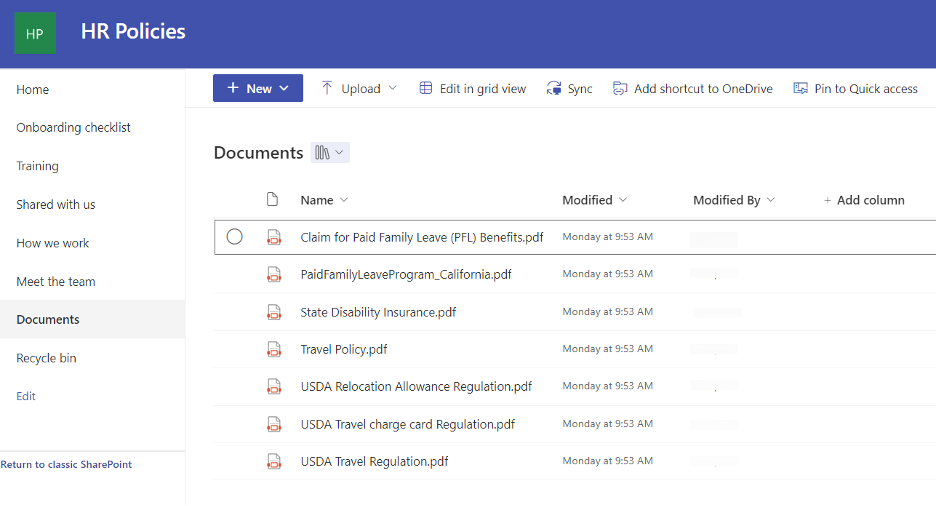
A listing is among the information storage mechanisms inside SharePoint. It gives the UI to view the gadgets in an inventory. You may add, edit, and delete gadgets or view particular person gadgets.
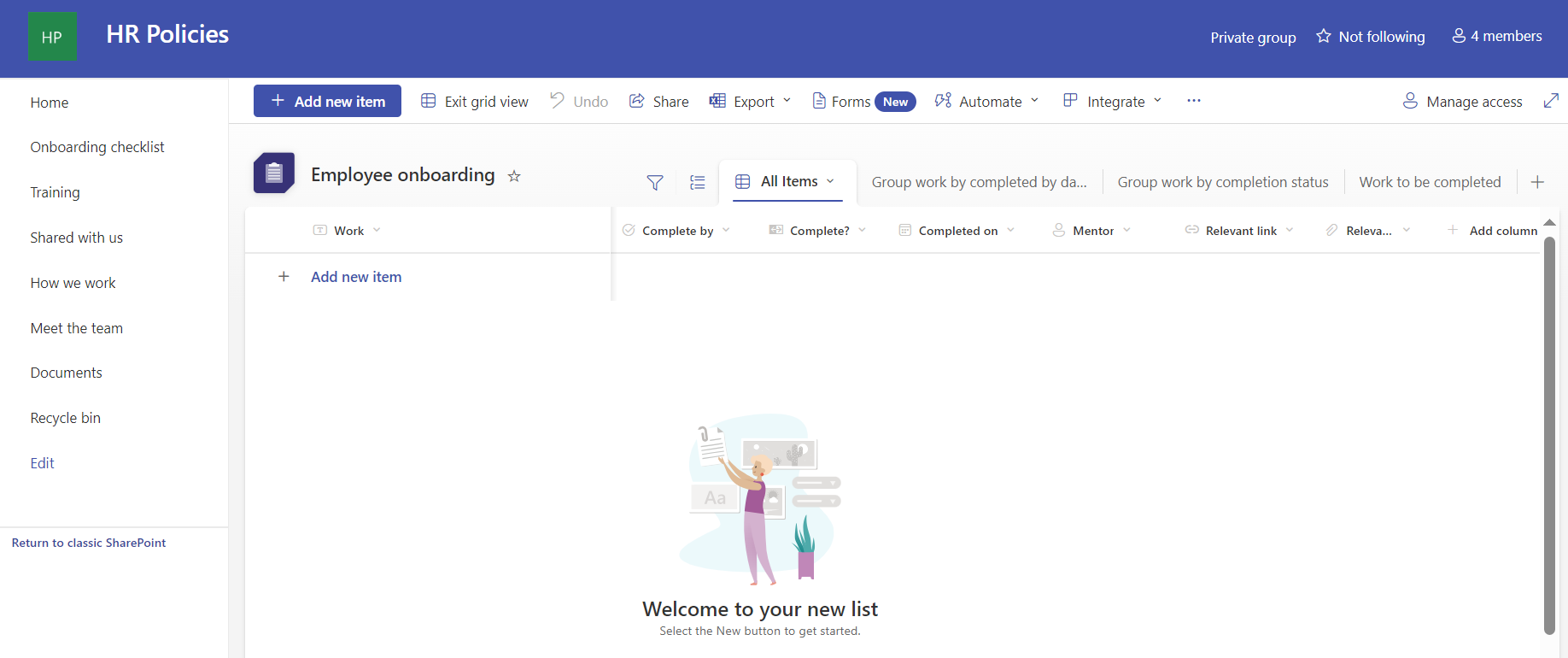
Overview of the SharePoint On-line connector for Amazon Q Enterprise
To crawl and index contents from SharePoint On-line, you possibly can configure the Amazon Q Enterprise SharePoint On-line connector as a knowledge supply in your Amazon Q enterprise utility. If you join Amazon Q Enterprise to a knowledge supply and provoke the sync course of, Amazon Q Enterprise crawls and indexes paperwork from the info supply into its index.
Let’s take a look at what are thought-about as paperwork within the context of Amazon Q enterprise SharePoint On-line connector. A doc is a set of knowledge that consists of a title, the content material (or the physique), metadata (information concerning the doc), and entry management checklist (ACL) info to ensure solutions are supplied from paperwork that the consumer has entry to.
The next entities in SharePoint are crawled and listed as paperwork together with their metadata and entry management info:
- Information
- Occasions
- Pages
- Hyperlinks
- Attachments
- Feedback
Amazon Q Enterprise crawls information supply doc attributes or metadata and maps them to fields in your Amazon Q index. Consult with Amazon Q Enterprise SharePoint On-line information supply connector discipline mappings for extra particulars.
Configure and put together the Amazon Q connector
Earlier than you index the content material from Microsoft SharePoint on-line, your must first set up a safe connection between the Amazon Q Enterprise connector for SharePoint On-line along with your SharePoint On-line occasion. To ascertain a safe connection, you want to authenticate with the info supply.
The next are the supported authentication mechanisms for the SharePoint connector:
- Primary Authentication
- OAuth 2.0 with Useful resource Proprietor Password Credentials Move
- Azure AD App-Solely (OAuth 2.0 Certificates)
- SharePoint App-Solely with Consumer Credentials Move
- OAuth 2.0 with Refresh Token Move
Safe querying with ACL crawling, identification crawling, and consumer retailer
Safe querying is when a consumer runs a question and is returned solutions from paperwork that the consumer has entry to and never from paperwork that the consumer doesn’t have entry to. To allow customers to do safe querying, Amazon Q Enterprise honors ACLs of the paperwork. Amazon Q Enterprise does this by first supporting the indexing of ACLs. Indexing paperwork with ACLs is essential for sustaining information safety, as a result of paperwork with out ACLs are thought-about public. At question time, the consumer’s credentials (electronic mail handle) are handed together with the question in order that solutions from paperwork which are related to the question and which the consumer is allowed to entry are displayed.
A doc’s ACL comprises info such because the consumer’s electronic mail handle and the native teams or federated teams (if Microsoft SharePoint is built-in with an identification supplier (IdP) akin to Azure Energetic Listing/Entra ID) which have entry to the doc. The SharePoint on-line information supply might be optionally linked to an IdP akin to Okta or Microsoft Entra ID. On this case, the paperwork in SharePoint On-line can have the federated group info.
When a consumer logs in to an online utility to conduct a search, the consumer’s credentials (akin to an electronic mail handle) must match that’s within the ACL of the doc to return outcomes from that doc. The net utility that the consumer makes use of to retrieve solutions could be linked to an IdP or AWS IAM Id Middle. The consumer’s credentials from the IdP or IAM Id Middle are referred to right here because the federated consumer credentials. The federated consumer credentials akin to the e-mail handle are handed together with the question in order that Amazon Q can return the solutions from the paperwork that this consumer has entry to. Nonetheless, typically this consumer’s federated credentials will not be current within the SharePoint On-line information supply or the SharePoint doc’s ACLs. As an alternative, the consumer’s native consumer alias, native teams that this native consumer alias is part of, or the federated teams that the federated consumer is part of can be found within the doc’s ACL. Subsequently, there’s a must map the federated consumer credential to the native consumer alias, native teams, or federated teams within the doc ACL.
To map this federated consumer’s electronic mail handle to the native consumer aliases, native teams, or federated teams, sure Amazon Q Enterprise connectors, together with the SharePoint On-line connector, present an identification crawler to load the identification info (native consumer alias, native teams, federated teams, and their mappings, together with another mappings to a federated consumer) from the linked information sources right into a consumer retailer. At question time, Amazon Q Enterprise retrieves the related native consumer aliases, native teams, and any federated teams from the consumer retailer and makes use of that together with the question for securely retrieving passages from paperwork that the consumer has entry to.
If you want to index paperwork with out ACLs, you could ensure they’re explicitly marked as public in your information supply.
Consult with How Amazon Q Enterprise connector crawls SharePoint (On-line) ACLs for extra particulars.
Amazon Q indexes the paperwork with ACLs and units the consumer’s electronic mail handle or consumer principal title for the consumer and the group title [site URL hash value | group name] for the native group within the ACL. If the SharePoint On-line information supply is linked to an IdP akin to Azure AD/Entra ID or Okta, the AD group title seen within the SharePoint web site is about because the federated group ACL. The identification crawler units these the identical because the principals together with the obtainable mappings within the consumer retailer. Any further mappings must be set within the consumer retailer utilizing the consumer retailer APIs.
Overview of resolution
This publish presents the steps to create a certificates and personal key, configure Azure AD (both utilizing the Azure AD console or a PowerShell script), and configure Amazon Q Enterprise.
For this publish, we use a SharePoint On-line web site named HR Insurance policies that hosts coverage paperwork in a Paperwork library and payroll tax paperwork in a Payroll Taxes library to stroll you thru the answer.
In one of many eventualities that we validate, a SharePoint consumer (Carlos Salazar) is a part of the SharePoint web site members group, and he has entry solely to coverage paperwork within the Paperwork library.
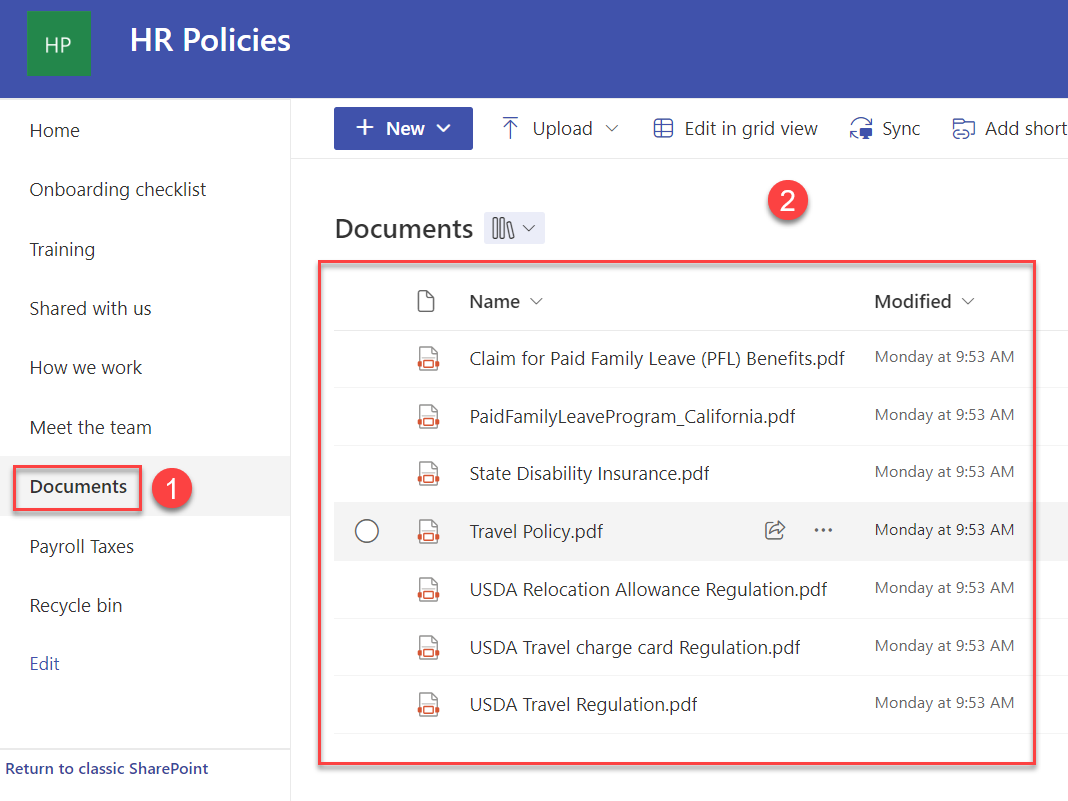
Carlos Salazar can obtain responses for queries associated to HR insurance policies, as proven within the following instance.

Nonetheless, for questions associated to payroll tax, he didn’t obtain any response.
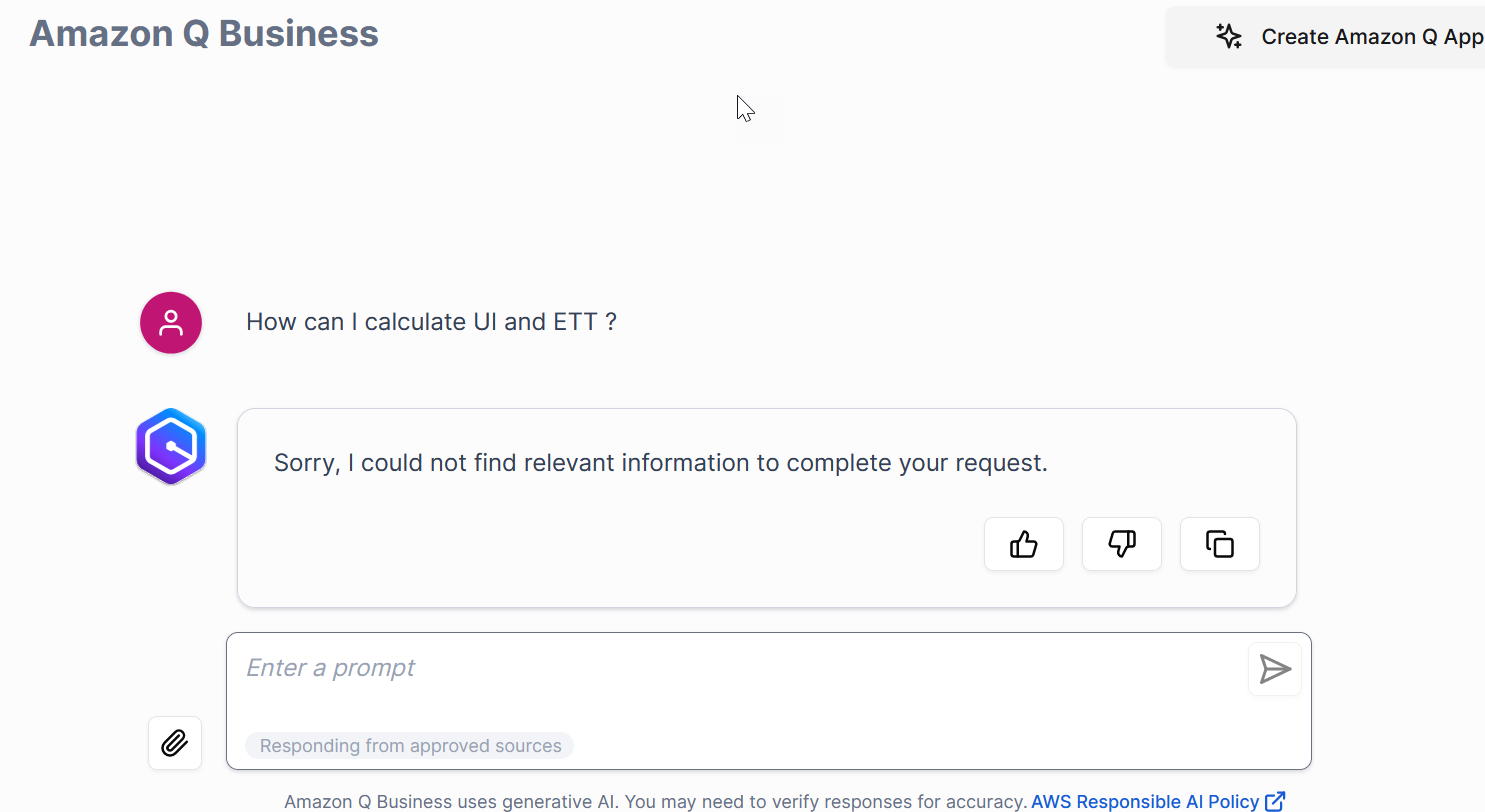
One other SharePoint consumer (John Doe) is a part of the SharePoint web site house owners group and has entry to each the Paperwork and Payroll Taxes libraries.
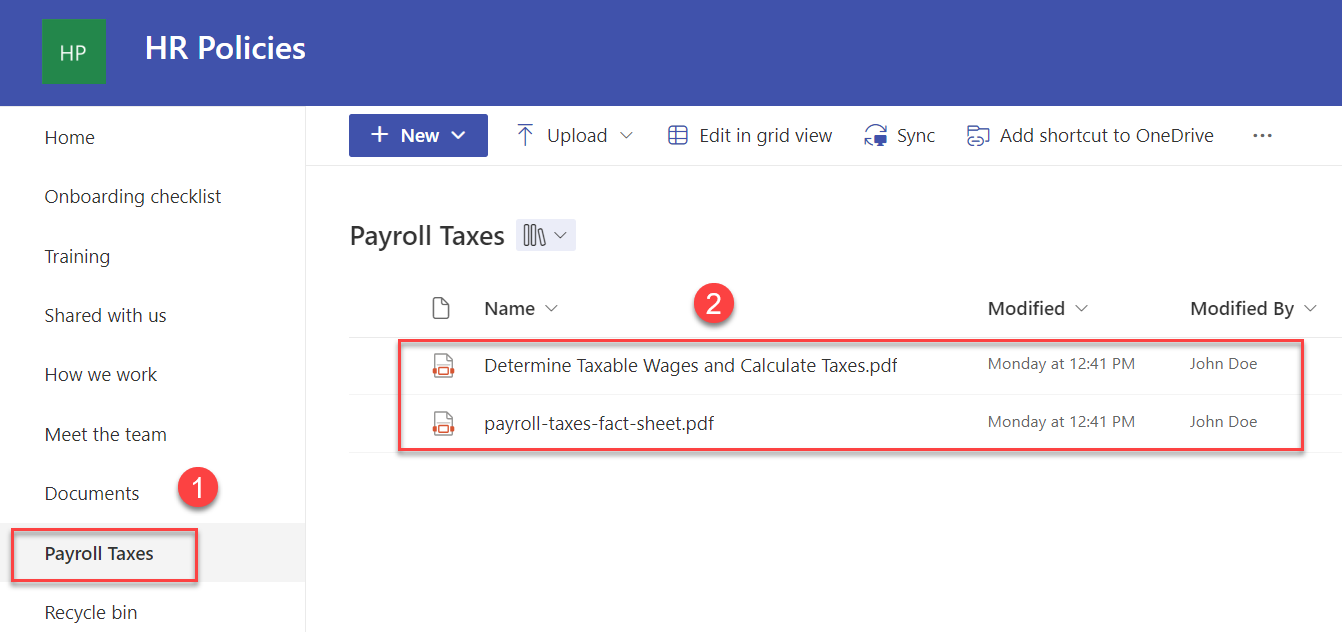
John Doe receives responses for queries associated to payroll taxes, as proven within the following instance.

Conditions
It is best to meet the next conditions:
- The consumer performing these steps must be a worldwide administrator on Azure AD/Entra ID.
- Configure Microsoft Entra ID and IAM Id Middle integration.
- You want a Microsoft Home windows occasion to run PowerShell scripts and instructions with PowerShell 7.4.1+. Particulars of the required PowerShell modules are described later on this publish.
- The consumer ought to have administrator permissions on the Home windows occasion.
- Ensure that the consumer operating these PowerShell instructions has the suitable M365 license (for instance, M365 E3).
Create the certificates and personal key
In Azure AD, when configuring App-Solely authentication, you usually use a certificates to request entry. Anybody with the certificates’s non-public key can use the app and the permissions granted to the app. We create and configure a self-signed X.509 certificates that will likely be used to authenticate Amazon Q in opposition to Azure AD, whereas requesting the App-Solely entry token. The next steps stroll you thru the setup of this mannequin.
For this publish, we use Home windows PowerShell to run just a few PowerShell instructions. You should utilize an present Home windows occasion or spin up a Home windows EC2 occasion or Home windows workstation to run the PowerShell instructions.
You should utilize the next PowerShell script to create a self-signed certificates. You can too generate the self-signed certificates by means of the New-PnPAzureCertificate command.
- Run the next command:
You can be requested to provide a password to encrypt your non-public key, and each the .PFX file and the .CER file will likely be exported to the present folder (the place you ran the PowerShell script from). Confirm that you simply now have a .cer and .pfx file.
- Add this .cer file to an S3 location that your Amazon Q IAM position has GetObject permissions for. You may let Amazon Q create this position for you in future steps outlined later on this publish, and the right permissions will likely be added for you in the event you select.
Now you extract the non-public key contents from the .pfx file and reserve it for Amazon Q connector configuration. This .pfx file will likely be current within the folder the place you will have saved the certificates.
- Run the next command to extract the non-public key:
You can be prompted for the import password. Enter the password that you simply used to guard your key pair while you created the .pfx file (shopper ID, in our case). You can be prompted once more to offer a brand new password to guard the .key file that you’re creating. Retailer the password to your key file in a safe place to keep away from misuse. (If you enter a password, the window exhibits nothing in the event you’re utilizing the Home windows CMD window. Enter your password and select Enter.)
- Run the next command to decrypt the non-public key:
- Run the next command to extract the certificates:
This decrypted key and certificates will likely be utilized by the connector for authentication functions.
- Add the X.509 certificates (ending with .crt) to an S3 bucket. This will likely be used when configuring the SharePoint On-line connector for Amazon Q.
- Confirm the contents of the file
amazonqbusinessdemo-decrypted.keybegins with the usualBEGIN PRIVATE KEYheader. - Copy and paste the contents of the
amazonqbusinessdemo-decrypted.keyto be used later in our Amazon Q setup.
- Confirm the contents of the file
Configure Azure AD
You may configure Azure AD utilizing both of the next strategies:
- Utilizing the Azure AD console GUI. It is a handbook step-by-step course of.
- Utilizing the supplied PowerShell script. That is an automatic course of that takes within the inputs and configures the required permissions.
Observe the steps for both choice to finish the Azure AD configuration.
Configure Azure AD utilizing the Azure AD console
To configure Azure AD utilizing the GUI, you first register an Azure AD utility within the Azure AD tenant that’s linked to the SharePoint On-line/O365 tenant. For extra particulars, see Granting entry by way of Azure AD App-Solely.
- Open the Workplace 365 Admin Middle utilizing the account of a consumer member of the Tenant World Admins group.
- Navigate to Microsoft Azure Portal.
- Seek for and select App registrations.
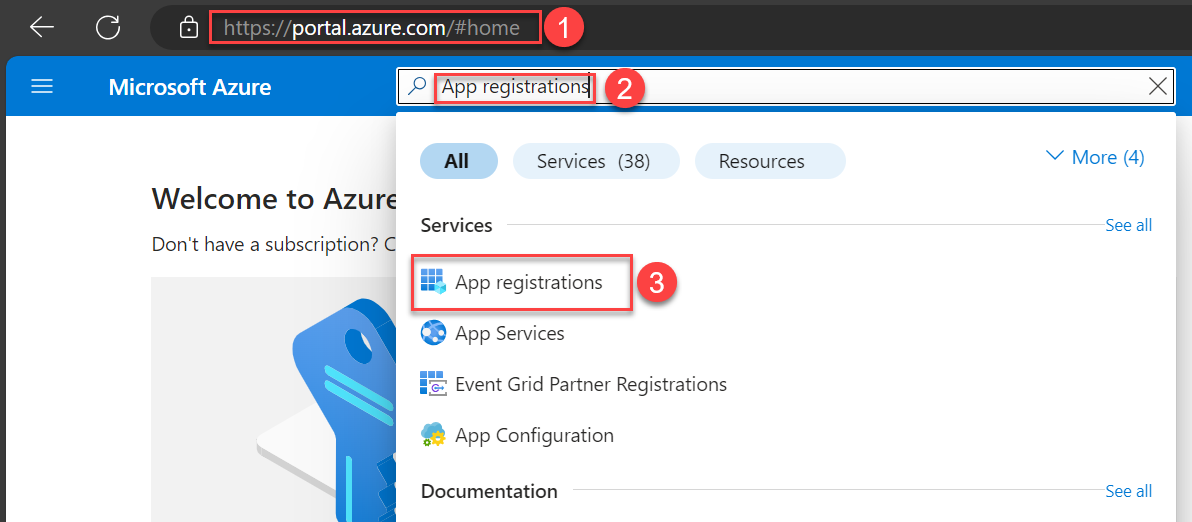
- Select New registration.

- Enter a reputation on your utility, choose who can use this utility, and select Register.
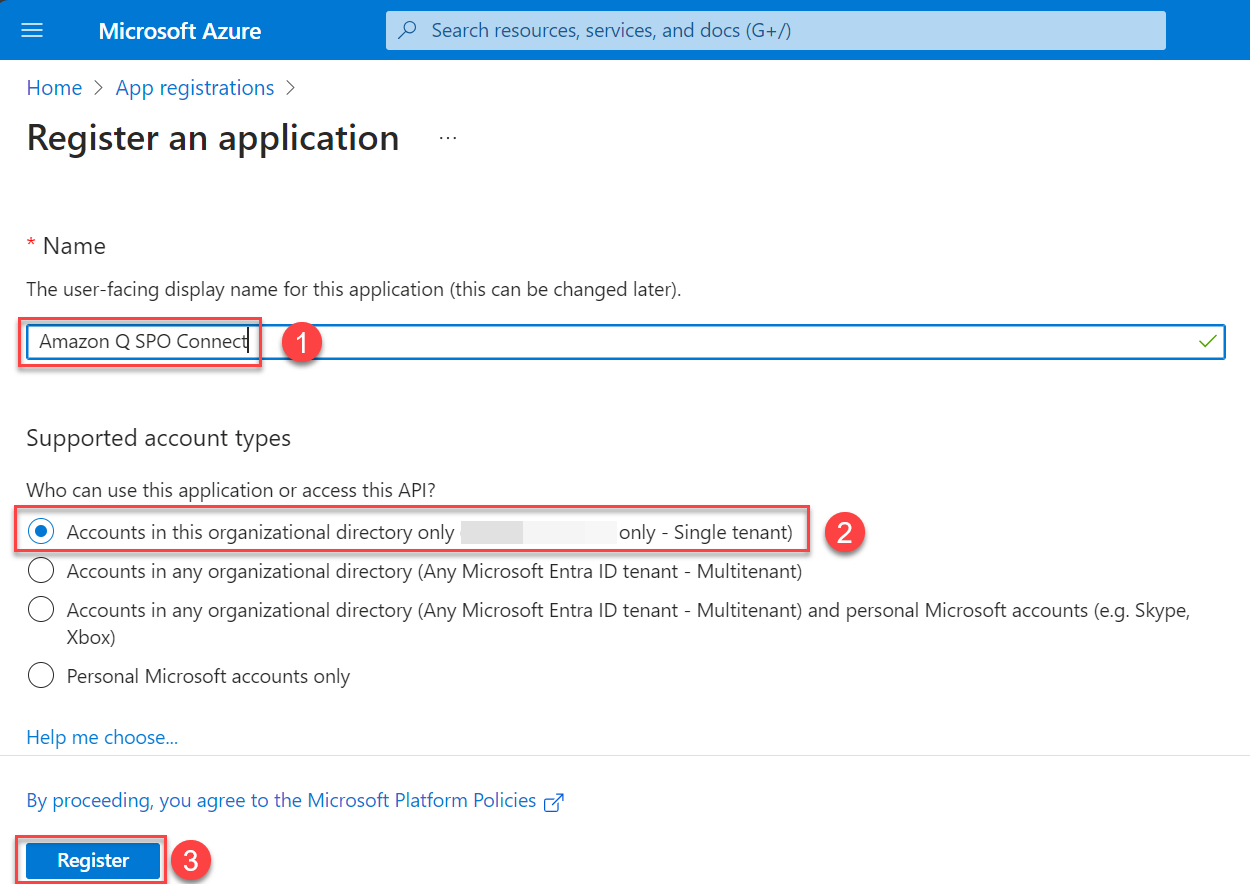
An utility will likely be created. You will note a web page like the next screenshot.
- Be aware the appliance (shopper) ID and the listing (tenant) ID.
These IDs will likely be completely different than what’s proven within the screenshot.

Now you possibly can configure the newly registered utility for SharePoint permissions.
- Select API permissions within the navigation pane.
- Select Add a permission so as to add the permissions to your utility.
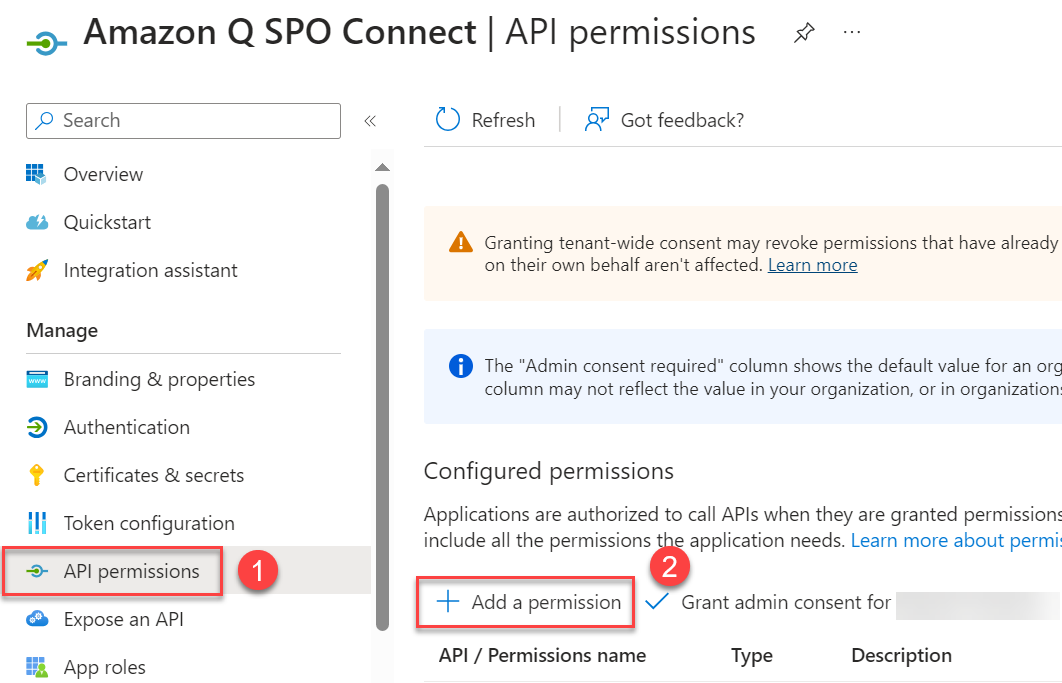
- Select SharePoint from the checklist of purposes.
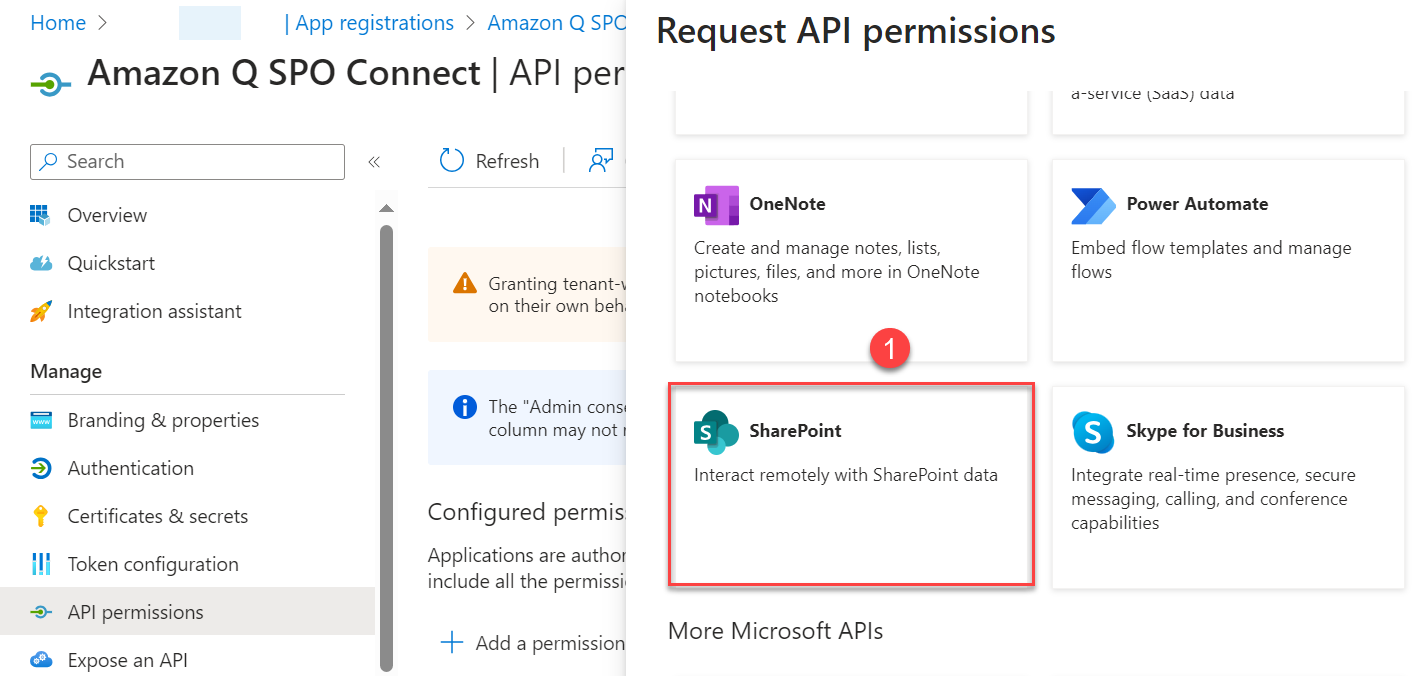
- Configure permissions.
There are two other ways to configure SharePoint permissions.
To configure permissions to entry a number of SharePoint Website collections (utilizing Azure AD App-Solely permissions), choose Website.FullControl.All to permit full management permissions to all of the SharePoint web site collections and to learn the ACLs from these web site collections.

This permission requires admin consent in a tenant earlier than it may be used. To take action, select Grant admin consent for <group title> and select Sure to verify.
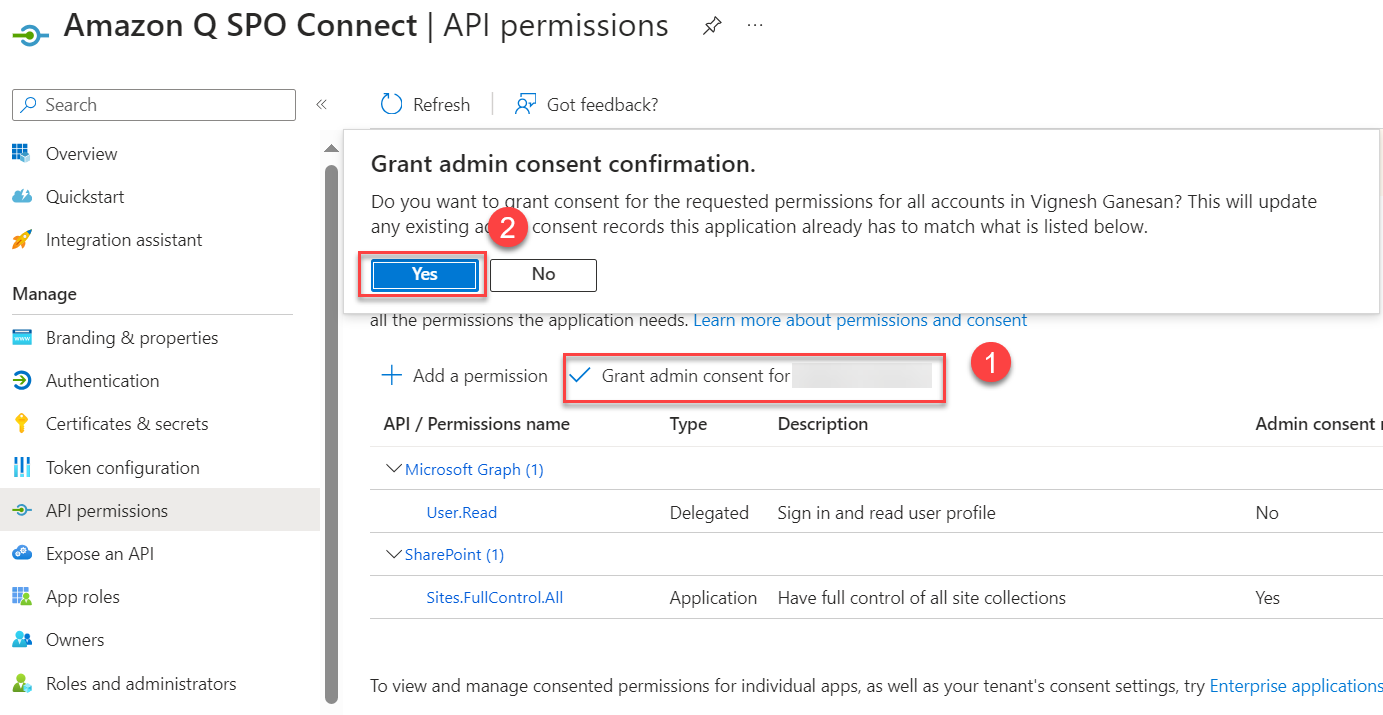
Alternatively, to configure permissions to entry particular SharePoint web site collections, choose Websites.Chosen to permit entry to a subset of web site collections and not using a signed-in consumer. The particular web site collections and the permissions granted will likely be configured in SharePoint On-line.

This permission requires admin consent in a tenant earlier than it may be used. To take action, select Grant admin consent for <group title> and select Sure to verify.
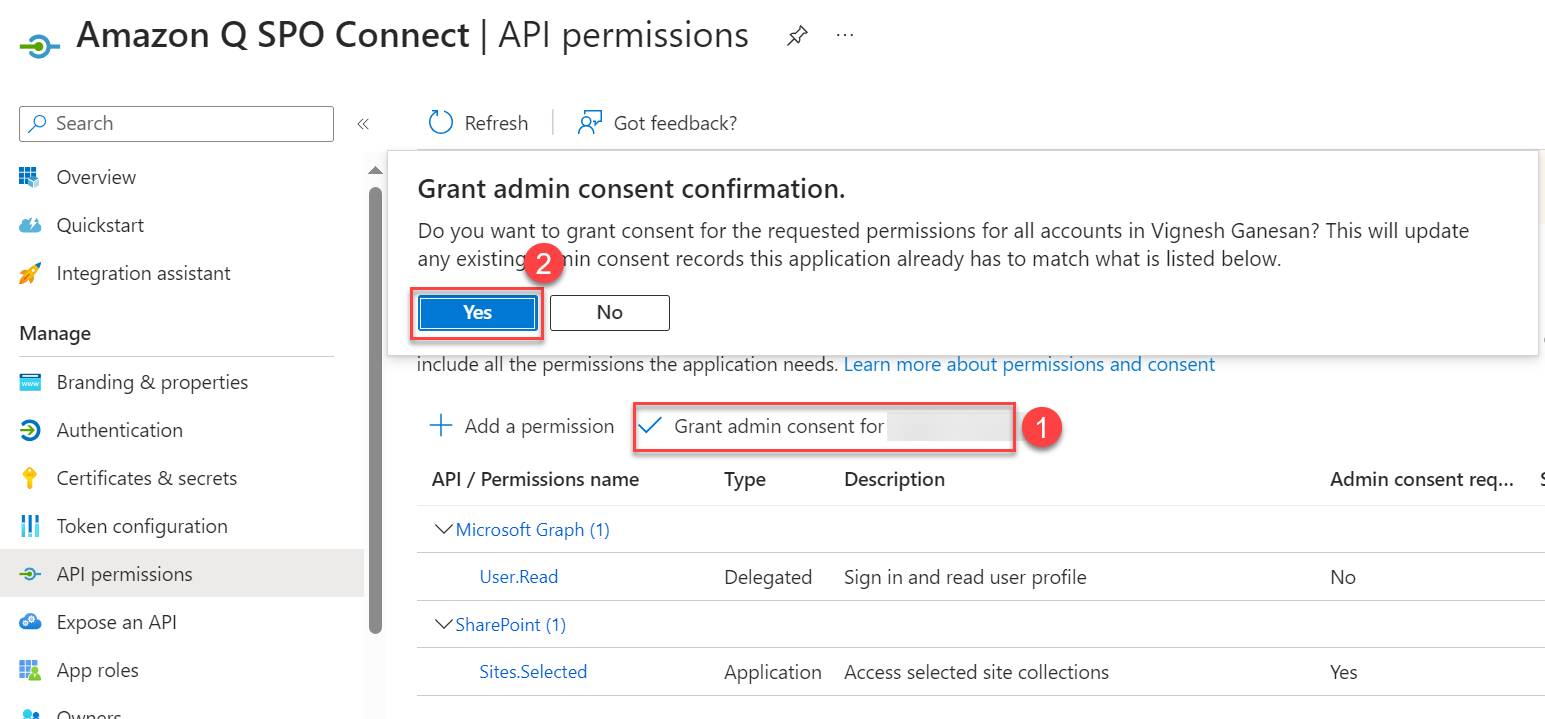
Subsequent, you grant Azure AD app permissions to a number of SharePoint web site collections. Ensure that the next conditions are in place:
- You will need to have Home windows Server/Workstation with PowerShell 7.4.1+.
- The consumer operating these PowerShell instructions will need to have the suitable M365 license (for instance, M365 E3).
- Set up the PowerShell modules utilizing
Set up-Module -Identify PnP.PowerShell -AllPreRelease. - If that is your first-time operating PowerShell instructions, run the
Join-PnPOnline -Url <web site assortment url> -PnPManagementShellPowerShell command and full the consent course of to make use of PnP cmdlets. Alternatively, run theRegister-PnPManagementShellAccesscmdlet, which grants entry to the tenant for the PnP administration shell multi-tenant Azure AD utility.
- Open PowerShell and hook up with SharePoint On-line utilizing the Join-PnPOnline command:
- Add the Azure AD app to a number of particular web site assortment permissions utilizing Grant-PnPAzureADAppSitePermission:
If you wish to configure permissions to multiple SharePoint On-line web site assortment, then you could repeat the previous PowerShell instructions for each assortment.
Now you’re prepared to attach the certificates.
- Select Certificates & secrets and techniques within the navigation pane.
- On the Certificates tab, select Add certificates.
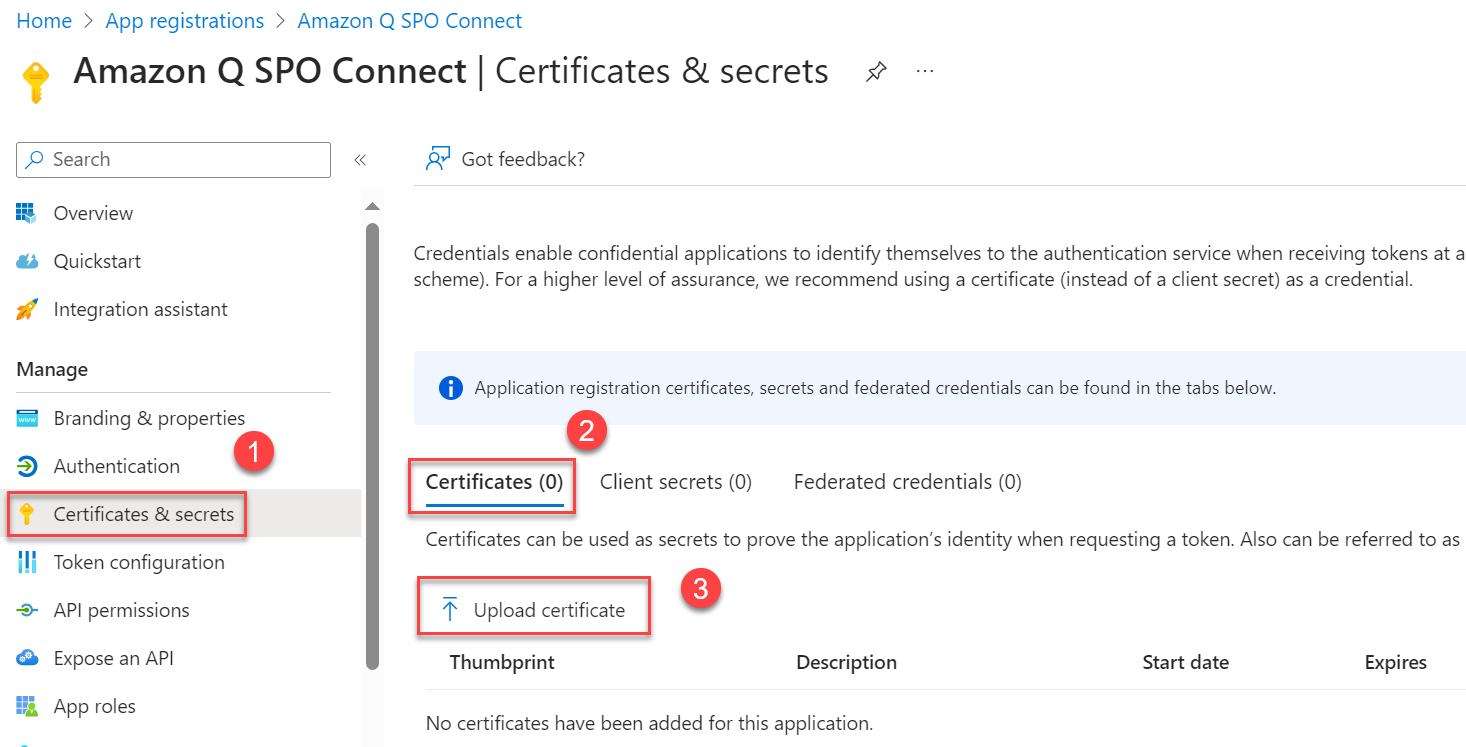
- Select the .cer file you generated earlier and select Add to add it.

This completes the configuration on the Azure AD facet.
Configure Azure AD utilizing the supplied PowerShell script
The consumer operating this PowerShell script must be an Azure AD tenant admin or have tenant admin permissions. Moreover, as a prerequisite, set up the MS Graph PowerShell SDK.
Full the next steps to run the PowerShell script:
- Run the PowerShell script and observe the directions.
This script will do the next:
- Register a brand new utility in Azure AD/Entra ID
- Configure the required SharePoint permissions
- Present admin consent for the permissions
The output from the PowerShell script will appear like the next screenshot.

- Should you selected Chosen because the permission to focus on a selected SharePoint Website assortment, proceed with the steps to configure a selected SharePoint Website assortment as talked about earlier.
- When you have multiple SharePoint web site assortment to be crawled, repeat the earlier step to configure every assortment.
Configure Amazon Q
Be sure to have arrange Amazon Q Enterprise with Entra ID as IdP as talked about within the conditions. Additionally, ensure the e-mail ID is in lowercase letters whereas creating the customers in Entra ID.
Observe the directions in Connecting Amazon Q Enterprise to SharePoint (On-line) utilizing the console.
For Step 9 (Authentication), we select Azure AD App-Solely authentication and configure it as follows:
- For Tenant ID, enter the tenant ID of your SharePoint account. This will likely be listing (tenant) ID in your registered Azure utility, within the Azure Portal, as proven within the following screenshot (the IDs will likely be completely different on your setup).
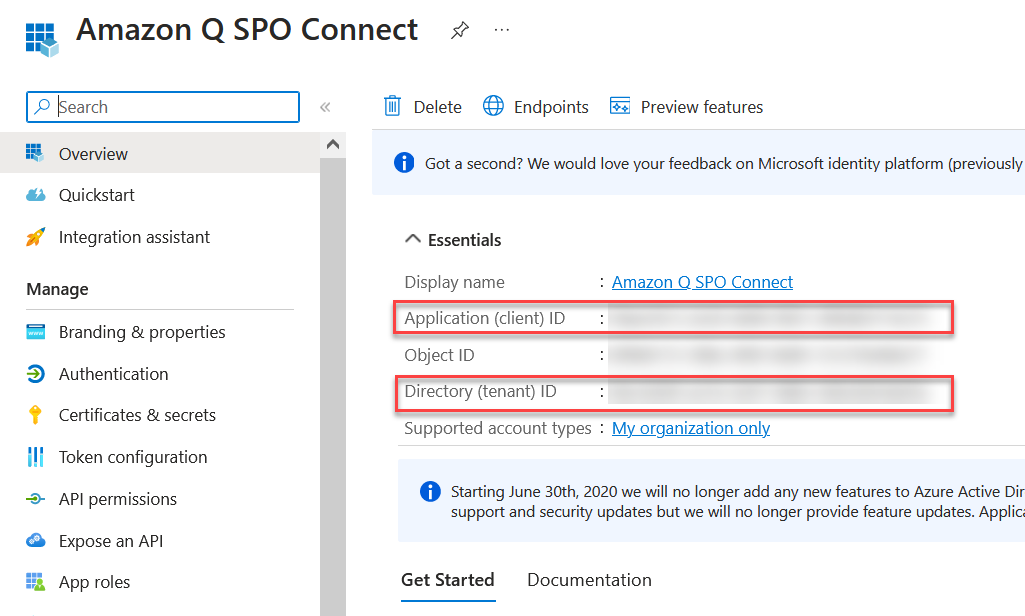
- For Certificates path, enter the full S3 path to your certificates (for instance,
s3://certBucket/azuread.crt). That is the Azure AD self-signed X.509 certificates to authenticate the connector for Azure AD. This certificates was created earlier. - For AWS Secrets and techniques Supervisor secret, create a secret in AWS Secrets and techniques Supervisor to retailer your SharePoint authentication credentials:
- For Secret title, enter a reputation on your secret.
- For Consumer ID, enter the Azure AD shopper ID generated while you registered SharePoint in Azure AD. That is the appliance (shopper) ID created within the Azure Portal when registering the SharePoint utility in Azure, as described earlier.
- For Non-public key, enter a non-public key to authenticate the connector for Azure AD. That is the contents of the .pfx file you created when registering your Azure SharePoint utility, as described earlier. Enter the decrypted contents of that .pfx file in its entirety. Select Present non-public key to confirm it matches the contents on your .pfx file.
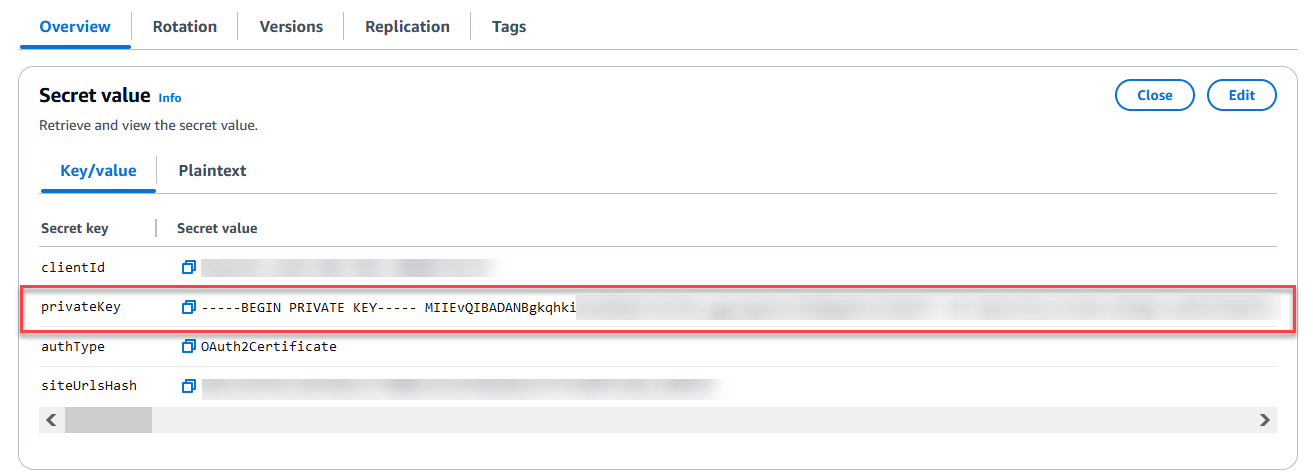
Proceed with the remainder of the steps in Connecting Amazon Q Enterprise to SharePoint (On-line) utilizing the console.
Entry the online expertise on Amazon Q
To entry the online expertise, full the next steps:
- On the Amazon Q Enterprise console, select Functions within the navigation pane.
- Select the appliance you created.
- Select the hyperlink beneath Internet expertise URL to browse Amazon Q.
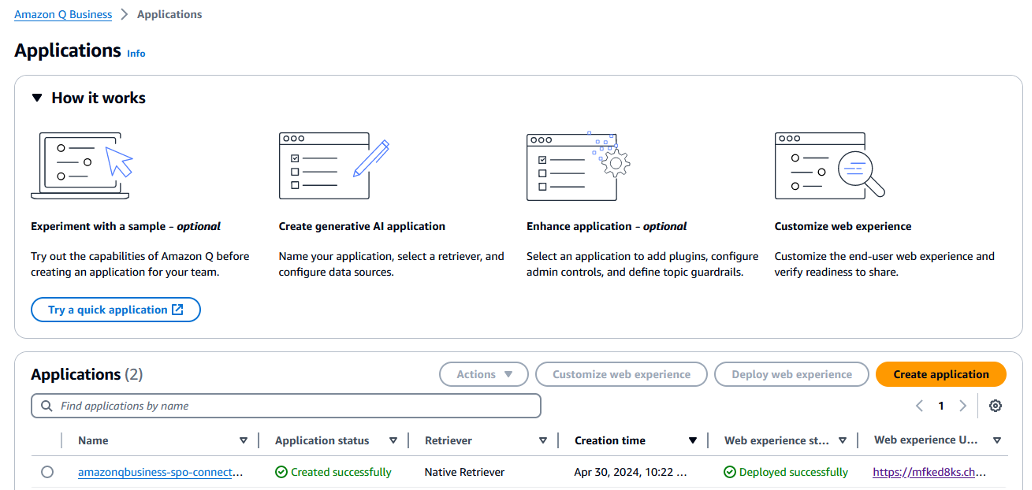
- When prompted, authenticate with Entra ID/Azure AD.
After you’re authenticated, you possibly can entry Amazon Q. You may ask Amazon Q a query and get a response based mostly on the permissions of the logged-in consumer.
References
- You may take a look at if the
Grant-PnPAzureADAppSitePermissioncmdlet labored by connecting to the SharePoint web site utilizing the Azure AD app that has the SharePoint.Websites.Chosen permission and run just a few SharePoint API calls:
- Make an observation of the certificates thumbprint as proven earlier.
- Set up the certificates for the present consumer within the Home windows Certificates Administration Retailer.
- Run the next PowerShell cmdlet to hook up with the SharePoint web site assortment utilizing
PnPOnline:
- Run
Get-PnPListto checklist all of the SharePoint lists within the web site assortment and make sure that the permissions are configured appropriately:
- Run
Troubleshooting
For troubleshooting steerage, consult with Troubleshooting your SharePoint (On-line) connector.
Clear up
Full the next steps to wash up your sources:
- Open the Workplace 365 Admin Middle utilizing the account of a consumer member of the Tenant World Admins group.
- Navigate to the Microsoft Azure Portal.
- Seek for and select App registrations.
- Choose the app you created earlier, then select Delete.
- On the Amazon Q Enterprise console, select Functions within the navigation pane.
- Choose the appliance you created, and on the Actions menu, select Delete.
Conclusion
On this publish, we explored how Amazon Q Enterprise can seamlessly combine with SharePoint On-line to assist enterprises unlock the worth of their information and data. With the SharePoint On-line connector, organizations can empower their workers to search out solutions shortly, speed up analysis and evaluation, streamline content material creation, automate workflows, and improve collaboration.
We walked you thru the method of organising the SharePoint On-line connector, together with configuring the mandatory Azure AD integration and authentication mechanisms. With these foundations in place, you can begin unlocking the total potential of your SharePoint funding and drive better productiveness, effectivity, and innovation throughout your online business.
Now that you simply’ve discovered tips on how to combine Amazon Q Enterprise along with your Microsoft SharePoint On-line content material, it’s time to unlock the total potential of your group’s data and information. To get began, join an Amazon Q Enterprise account and observe the steps on this publish to arrange the SharePoint On-line connector. Then you can begin asking Amazon Q pure language questions and watch because it surfaces probably the most related info out of your firm’s SharePoint websites and paperwork.
Don’t miss out on the transformative energy of generative AI and the Amazon Q Enterprise platform. Join at present and expertise the distinction that Amazon Q could make on your group’s SharePoint-powered data and content material administration.
Concerning the Authors
 Vijai Gandikota is a Principal Product Supervisor on the Amazon Q and Amazon Kendra staff of Amazon Internet Providers. He’s chargeable for the Amazon Q and Amazon Kendra connectors, ingestion, safety, and different elements of Amazon Q and Amazon Kendra.
Vijai Gandikota is a Principal Product Supervisor on the Amazon Q and Amazon Kendra staff of Amazon Internet Providers. He’s chargeable for the Amazon Q and Amazon Kendra connectors, ingestion, safety, and different elements of Amazon Q and Amazon Kendra.
 Satveer Khurpa is a Senior Options Architect on the GenAI Labs staff at Amazon Internet Providers. On this position, he makes use of his experience in cloud-based architectures to develop modern generative AI options for shoppers throughout various industries. Satveer’s deep understanding of generative AI applied sciences permits him to design scalable, safe, and accountable purposes that unlock new enterprise alternatives and drive tangible worth.
Satveer Khurpa is a Senior Options Architect on the GenAI Labs staff at Amazon Internet Providers. On this position, he makes use of his experience in cloud-based architectures to develop modern generative AI options for shoppers throughout various industries. Satveer’s deep understanding of generative AI applied sciences permits him to design scalable, safe, and accountable purposes that unlock new enterprise alternatives and drive tangible worth.
 Vijai Anand Ramalingam is a Senior Modernization Architect at Amazon Internet Providers, specialised in enabling and accelerating prospects’ utility modernization, transitioning from legacy monolith purposes to microservices.
Vijai Anand Ramalingam is a Senior Modernization Architect at Amazon Internet Providers, specialised in enabling and accelerating prospects’ utility modernization, transitioning from legacy monolith purposes to microservices.
 Ramesh Jatiya is a Senior Options Architect within the Impartial Software program Vendor (ISV) staff at Amazon Internet Providers. He’s enthusiastic about working with ISV prospects to design, deploy, and scale their purposes within the cloud to derive enterprise worth. He’s additionally pursuing an MBA in Machine Studying and Enterprise Analytics from Babson Faculty, Boston. Exterior of labor, he enjoys operating, enjoying tennis, and cooking.
Ramesh Jatiya is a Senior Options Architect within the Impartial Software program Vendor (ISV) staff at Amazon Internet Providers. He’s enthusiastic about working with ISV prospects to design, deploy, and scale their purposes within the cloud to derive enterprise worth. He’s additionally pursuing an MBA in Machine Studying and Enterprise Analytics from Babson Faculty, Boston. Exterior of labor, he enjoys operating, enjoying tennis, and cooking.
 Neelam Rana is a Software program Growth Engineer on the Amazon Q and Amazon Kendra engineering staff. She works on Amazon Q connector design, growth, integration, and take a look at operations.
Neelam Rana is a Software program Growth Engineer on the Amazon Q and Amazon Kendra engineering staff. She works on Amazon Q connector design, growth, integration, and take a look at operations.
 Dipti Kulkarni is a Software program Growth Supervisor on the Amazon Q and Amazon Kendra engineering staff of Amazon Internet Providers, the place she manages the connector growth and integration groups.
Dipti Kulkarni is a Software program Growth Supervisor on the Amazon Q and Amazon Kendra engineering staff of Amazon Internet Providers, the place she manages the connector growth and integration groups.





